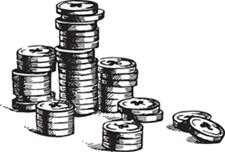
Scrooge never painted out Old Marley’s name. There it stood, years afterwards, above the warehouse door: Scrooge and Marley. The firm was known as Scrooge and Marley.
While Charles Dickens never tells us precisely where Ebenezer Scrooge’s counting house was located, the clues in A Christmas Carol suggest it was in the City of London. The “City” refers to a particular area of London, the core of roughly one square mile (it is even called “The Square Mile” colloquially) from which the capital historically grew. It was and continues to be the center of finance and commerce in London.
Indeed, today one can pass Simpson’s, which has been serving mutton chops and roast beef to well-dressed City gentlemen since 1757.
“It was within this maze of alleyways that Dickens placed the counting house,” wrote Richard Jones. “In this quaint, atmospheric backwater of twisting passage ways and dark courtyards, time appears to have stood still, and it is not difficult to conjure up images of Scrooge’s neighbors ‘wheezing up and down, heating their hands on their breasts, and stamping their feet upon the pavement stones to warm them.’ ”
We can guess this location partly because Scrooge is a trader, merchant, or businessman of some sort, but also because Dickens mentions several parts of the City by name. St Paul’s Cathedral, with its famous dome, is mentioned in Stave I. And on his way home to Camden Town, Bob Cratchit (we only know him as Scrooge’s anonymous clerk at this stage) slides down Cornhill (a City street) on the ice. As Camden Town is several miles northwest of the City, Scrooge’s offices would certainly be somewhere east or south of Cornhill.
Describing the immediate vicinity of the office, Dickens mentions a courtyard and “the ancient tower of a church, whose gruff old bell was always peeping slyly down at Scrooge out of a Gothic window in the wall.” The church may well be St Michael’s, Cornhill, on which basis the City of London’s Dickens Walk identifies the exact site of Scrooge & Marley’s as Newman’s Court.
Newman’s Court is off the north side of Cornhill about 165 yards east of Bank Station and just east of Finch Lane. Located in the financial heart of the city, opposite the towering spire of St Michael’s, Cornhill is the little covered alley where a Mr. Newman and his family set up home in 1650 amidst a bustling market. In the many changes that Cornhill has seen over the centuries and in this heyday of modern development when concrete frames filled with plate glass are shooting forever skyward, it is amazing how this Court and numerous others have survived. Old Newman would hardly recognize it now, with cars of Midland Bank employees parked where his house once stood. But, along with his descendants, he would probably be overjoyed to find it still here at all.
Newman’s Court first became famous in 1652 when the first public coffeehouse in London opened there. A merchant by the name of Edwards, who traded in Turkey, brought with him some bags of coffee from the Levant, and a Greek servant knew how to prepare the blend. The new elixir was an instant success with Edwards’ friends. The Greek servant, Pasquet (some have it as Pasqua), then opened the first public coffee house in London. It was an instant success.
Once upon a time—of all the good days in the year, on Christmas Eve—old Scrooge sat busy in his counting-house. It was cold, bleak, biting weather . . . .
A counting house, or compting house, literally is the building, room, office, or suite in which a business firm carries on operations, particularly accounting. By a synecdoche, it has come to mean the accounting operations of a firm, however housed. The term is British in origin and is primarily used in the context of the nineteenth century or earlier periods. Counting house is also the name given to early businesses which safely stored public and private money and loaned money.
By today’s standard definitions, a counting house would be called an accountant’s office. In Victorian England, these offices handled financial transactions for clients, such as collecting rent, paying bills, auditing etc. It also probably served the function of being a loan office or a collection office. Clerks and executives would literally be counting money in the “counting house.” Then they would fill out the ledgers of their clients and harbor the money collected. Such offices would be filled with numerous ledgers, which required constant copying, and large and small cash boxes with which to keep the money safe.
It has been pointed out by literary historian Ruth Richardson that Dickens might have gotten the name for the firm of Scrooge and Marley from a sign from a neighborhood where he lived in his late teens. Richardson pointed out that Dickens’ address at this time had changed over the years, and that the east Marleybone Street address had become 22 Cleveland Street, and before that it was 10 Norfolk Street. She further revealed that in the same neighborhood at the same time there was a sculptor who was derided by locals as a miser, and also that there was a sign nearby with the name “Goodge and Marney” signaling the workplace of two tradesmen, and finally a local cheesemonger by the name of “Marley.” There is little question that these names probably figured into Dickens’ process of creating the enigmatic sign hanging above old Scrooge’s office. It seems that, in addition to the reference above, the name “Marley” showed up in a lot of places where Dickens might have poached it from.